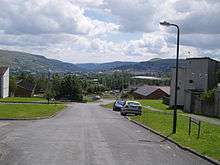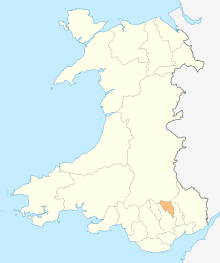Beaufort, Blaenau Gwent
Beaufort (Welsh: Cendl or Y Cendl) is a village and community located in the historic county of Brecknockshire (Breconshire) and the preserved county of Gwent. It currently lies on the northern edge of the county borough of Blaenau Gwent in Wales. According to the 2011 census, the population of the ward and community of Beaufort is 3,866[1]
Beaufort
| |
|---|---|
 Carno reservoir, Rassau, Beaufort | |
 Beaufort Location within Blaenau Gwent | |
| Population | 3,866 [1] |
| Principal area | |
| Ceremonial county | |
| Country | Wales |
| Sovereign state | United Kingdom |
| Post town | EBBW VALE |
| Postcode district | NP23 |
| Dialling code | 01495 |
| Police | Gwent |
| Fire | South Wales |
| Ambulance | Welsh |
| UK Parliament | |
| Senedd Cymru – Welsh Parliament |
|

The settlement arose on the boundary of two parishes, Llangattock in Brecknockshire and Aberystruth in Monmouthshire on the 1779 establishment of the Beaufort Iron Works by Edward and Jonathan Kendall (Cendl) after whom the new settlement was first named. NB The photograph is of the 'New Rassau estate'. Built late fifties-seventies. The information above, pertains to the village commonly known as 'The Old Rassau', but recognised by the local Authority as one community called 'Rassau'.
Description
The village's name derives from the fact that much of the local land was originally owned by the Duke of Beaufort. The border between Beaufort and Ebbw Vale itself is generally considered to be the Ebbw River which passes close to St David's Church (Church in Wales).
'Carmeltown', presumably so-called because of the presence of Carmel Chapel, lies between the Rassau and the rest of Beaufort. Confusingly, the 'rest of Beaufort' (i.e. geographically the eastern part of Beaufort) is frequently simply referred to as 'Beaufort' or 'Beaufort Hill'.

The eastern end of Beaufort is more densely populated than Carmeltown or the border areas of Rassau or Brynmawr. Beaufort was administratively part of Brecknockshire, but was transferred to the administrative county of Monmouthshire as part of the urban district of Ebbw Vale in 1888. However, even in the 1920s, 'Beaufort Breconshire' was still widely used in postal correspondence. Subsequent local government changes incorporated it into the Blaenau Gwent district of Gwent in 1974 and the unitary authority of Blaenau Gwent in 1996.
Beaufort and parts of nearby Badminton and Rassau are widely seen as being some of the most affluent areas in the County. House prices in these area are some of the most expensive in the area, with a new housing development at the top of Beaufort Hill being developed with house starting around £200,000 - £300,000.
The village also has a theatre with a ball room where many famous people played at the start of their careers. One of the most famous was Tommy Scott who later went on to become known worldwide as Sir Tom Jones.
Up until 1958 the village was served by Beaufort railway station, a station on the LNWR railway line from Abergavenny - Merthyr.
In 2010 the Beaufort community (civil parish) was replaced by three smaller communities, named Beaufort (including the village and the area to the north), Badminton (to the south) and Rassau (to the west).[2]
Welsh
Historically, the language of Beaufort was Welsh. The Reverend Peter Williams' monograph, 'The Story of Carmel', concerning Carmel Congregational Church (chapel) in Beaufort, published in 1965 is useful here. Williams reports that between 1904 and 1906, the change was made to conduct the morning Sunday service (the less prestigious service) in English, whereas previously both the morning and evening services had been in Welsh. This is consistent with Beaufort being bilingual with both Welsh and English-language chapels until at least the end of the 19th century with the Welsh language surviving well into the 20th century before rapidly disappearing as a native language by World War II. Elements of a Welsh service continued (e.g. in Carmel Chapel) until the 1970s. Amongst its Nonconformist chapels, the Welsh Independent Congregational Chapel 'Carmel' was pre-eminent, rising to national fame under the leadership of Thomas Rees DD (author of History of Protestant Nonconformity in Wales, whose second edition was printed in 1883). According to the 2001 census, 440 residents, or 11.7% of the village's population aged 3 and over can now speak Welsh.[3] This gives Beaufort the highest percentage of Welsh Speakers in Blaenau Gwent.
Places of interest in Beaufort
Parc Nant y Waun is a nature reserve incorporating 22 hectares of grassland, mires and reservoirs which was officially opened in 2007.[4] Home to many wildlife species, it includes a picnic area, outdoor classroom and angling Club.[5]
Carmel Chapel, referred to above, is a Grade II listed building[6][7][8][9][10]
Culture
The Beaufort Male Choir originally formed in 1897, are still going strong today with over sixty singers from all over Gwent. They have performed in many prestigious venues all around the world, and are one of the most famous choirs in Wales.[11]
The Beaufort Male Choir, one of the oldest in Wales, was founded at the end of the eighteenth century. Today’s choir was reformed after the Second World War in 1947 and this year we are celebrating sixty years of successful music making. Though times and circumstances have changed, we, like our predecessors still aspire to the highest ideals of male voice singing. However, whereas they placed great emphasis on competition in Eisteddfodau with significant success, we for the past forty years have concentrated exclusively on concert work This allows us greater musical freedom and affords us the opportunity of performing in the principal concert halls through the UK and Europe.
One of the most noticeable changes in perspective has occurred in recent years with the introduction of an international dimension. For in those years the choir has undertaken tours to Germany, Malta, France, the Netherlands and the Republic of Ireland. In addition, the choir has played host to choirs from Germany, the Netherlands, the United States and Japan. Among the highlights in recent years was the accolade of singing before heads of state at Kensington Palace and also before His Royal Highness the Prince of Wales. Annual Concert 2009 with RHYDIAN. Also concerts at La Maison Blance in Oxford and St Mary's Chapel in Westminster.
Under the musical direction of Craig James and Accompanist Margaret Davies, the choir has a much varied repertoire ranging from Welsh and English Hymns, spirituals and modern ballads as well as the more traditional male voice works. 2011 Annual concert featured Hayley Westenra. In May 2012 the choir performed at Ebbw Vale with the famous tenor Alfie Boe and performed with Katie Treharne from the West Ends production of Phantom of the Opera in September.
Margaret Davies, the choir's accompanist for 43 years has been named on Her Majesty the Queens New Years Honours list, she received the BEM for services to Music and the Community
Industrial history
Beaufort Iron Works
Edward (1750–1807) and Jonathan Kendall or Cendl of Dan-y-Parc Crickhowell established these works in 1779 on a 99-year lease. In 1833, by which time there were four furnaces, the works were taken over as an extension of their Nantyglo operations by the Bailey brothers, Joseph and Crawshay who put their sister’s son, William Partridge (1800–1862), in charge. Unmarried Agents (senior managers) of the local iron works companies lodged at the Rhyd-y-Blew, a drovers' inn, properly the hunting lodge of the Duke of Beaufort who carried out an annual rough-shoot of the area. The inn was at the end of the toll road from Merthyr Tydfil and for the rest of the year provided the drovers’ animals very good pasture and water in the Ebbw river. Suffolk-born Partridge married Charlotte Bevan, daughter of the Rhyd-y-Blew’s innkeeper, and remained in charge of the Beaufort iron works until his early death in 1862. The works soon closed. In conjunction with the then well-known Needham family of Beaufort mining engineers Partridge sons became involved in local collieries and established the substantial business later known as Partridge Jones. Grandson, rugby international and Barbarian, "Birdie" Partridge founded the Army Rugby Union. The Beaufort works house eventually became a fever hospital in 1902 and has since been demolished.
The ground, just south of Beaufort Hill, and close to a Chapel of Rest in the area known as Glanyafon, once occupied by the iron works has long been cleared and covered with houses. Giant pieces of slag remained in place until the most recent developments.
See also
References
- Census 2011 Statistics Overview: Beaufort Ward Profile Archived 2014-12-13 at the Wayback Machine. Blaenau Gwent County Borough Council. Retrieved 9 April 2014.
- "The Blaenau Gwent (Communities) Order 2010". Legislation.gov.uk. Retrieved 17 June 2018.
- Spreading the Word: the Welsh Language 2001
- Opening of Parc Nant y Waun Archived 2011-06-12 at the Wayback Machine
- Angling Club
- "Welsh chapels disappearing at rate of one a week - Wales Online". walesonline.co.uk. Retrieved 13 December 2014.
- "Beaufort Monumental Inscriptions - Parish Chest". parishchest.com. Retrieved 13 December 2014.
- "BBC - Your Paintings - Carmel Chapel, Beaufort, Glyn Ebwy, 1865". bbc.co.uk. Retrieved 13 December 2014.
- Great Britain. Parliament. House of Lords (1856). Journals of the House of Lords. 88. H.M. Stationery Office. p. 43. Retrieved 13 December 2014.
- "Carmel Congregational Church, Beaufort | The National Archives". nationalarchives.gov.uk. Retrieved 13 December 2014.
- "Beaufort Male Choir - Beaufort Male Choir". beaufortmalechoir.com. Retrieved 13 December 2014.
External links
- History of Beaufort from The History of Brecknockshire by Theophilus Jones.
- www.geograph.co.uk : photos of Beaufort and surrounding area
- "Beaufort Male Choir - Beaufort Male Choir". beaufortmalechoir.com. Retrieved 13 December 2014.
- "Tredegar's Paralympic hero, Mark Colbourne, among Gwent honours (From South Wales Argus)". southwalesargus.co.uk. Retrieved 13 December 2014.
